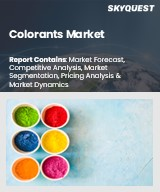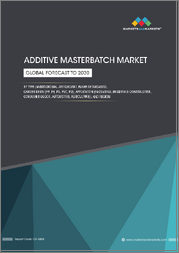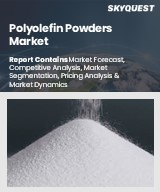
|
시장보고서
상품코드
1596818
세계의 마스터 배치 시장 규모, 점유율, 성장 분석(유형별, 용도별, 최종 사용자별, 지역별) : 산업 예측(2024-2031년)Masterbatch Market Size, Share, Growth Analysis, By Type, By Carrier Polymer(Polypropylene, Polyethylene, Polyvinyl Chloride, Polyethylene Terephthalate ), By End-user, By Region - Industry Forecast 2024-2031 |
||||||
세계의 마스터 배치 시장 규모는 2022년에 119억 달러로 평가되었고, 2023년 126억 달러에서 2031년에는 191억 달러로 확대되었으며, 예측 기간 중(2024-2031년) CAGR은 5.4%로 성장할 전망입니다.
마스터 배치 시장은 주로 금속 부품의 플라스틱 재료에 대한 대체가 진행되고 있으며 플라스틱 제품의 서비스 수명이 향상됨에 따라 성장이 예상됩니다. 자동차 업계에서는 플라스틱 사용량을 늘려 차량을 경량화하려는 현저한 동향이 시장 확대를 더욱 뒷받침하고 있습니다. 동시에 자동차와 건설활동의 견조한 성장으로 음향 솔루션, 복합재료, 조명, 채광창, 창유리 등 다양한 용도로 엔지니어링 플라스틱 수요가 높아질 것으로 예상됩니다. 그러나 이러한 성장 궤도는 특히 중국을 비롯한 신흥 국가에서 저비용 제품을 제공하는 과제에 직면하여 시장 전체의 성장을 방해할 수 있습니다. 게다가 시장 경쟁은 포화 상태에 있어 신규 진입은 어렵지만, 저품질 생산자는 이 역학의 틈을 뚫을 수 있습니다. 재생 플라스틱에 사용되는 마스터 배치에는 안정제, 착색제, 난연제 등의 첨가제가 포함되어 있기 때문에 지속가능성 문제가 발생합니다. 재생 플라스틱의 비생분해성은 플라스틱 제조 분야의 기업에 어려움을 겪고 있습니다. 게다가 특히 유럽에서는 플라스틱 재활용이 환경에 미치는 영향으로부터 일회용 플라스틱의 금지를 정한 엄격한 규제가 있어 포장 등 급성장 분야에서의 플라스틱의 용도에 영향을 미치려 하고 있습니다. 따라서 마스터 배치 시장은 환경 문제와 규제 문제를 해결하면서 성장 기회를 효과적으로 활용하기 위해 이러한 복잡한 상황을 극복해야합니다.
목차
소개
- 분석 목적
- 정의
- 시장 범위
분석 기법
- 정보 조달
- 2차 데이터 소스와 1차 데이터 소스
- 시장 규모 예측
- 시장의 상정과 제한
주요 요약
- 시장 개요와 전망
- 수급 동향의 분석
- 부문별 기회 분석
시장 역학과 전망
- 시장 개요
- 시장 규모
- 시장 역학
- 성장 촉진요인과 기회
- 억제요인과 과제
- Porter's Five Forces 분석과 영향
- 경쟁 기업간 경쟁 관계
- 대체품의 위협
- 구매자의 협상력
- 신규 진입업자의 위협
- 공급기업의 협상력
주요 시장 인사이트
- 중요성공요인
- 경쟁도
- 주요 투자 기회
- 시장 생태계
- 기술 분석
- 규제 상황
- 특허 분석
- 밸류체인 분석
- 사례 연구 분석
- 시장 매력도 지수
세계의 마스터 배치 시장 규모(유형별), CAGR(2024-2031년)
- 시장 개요
- 착색료
- 표준색
- 특수색
- 메탈릭
- 진주광택
- 형광
- 인광
- 주문제작 착색료
- 첨가물
- 항균 첨가제
- 산화방지제 첨가물
- 1차
- 2차
- 1차?2차
- 난연성
- UV 안정제
- 발포제
- 형광 증백제
- 핵제
- 화이트
- 블랙
- 필러
세계의 마스터배치 시장 규모(폴리머별), CAGR(2024-2031년)
- 시장 개요
- 폴리프로필렌(PP)
- 저밀도 폴리에틸렌·직쇄상 저밀도 폴리에틸렌(LDPE·LLDPE)
- 고밀도 폴리에틸렌(HDPE)
- 폴리염화비닐(PVC)
- 폴리우레탄(PUR)
- 폴리에틸렌테레프탈레이트(PET)
- 폴리스티렌(PS)
- 기타
세계의 마스터 배치 시장 규모(용도별), CAGR(2024-2031년)
- 시장 개요
- 포장
- 경질 포장
- 연질 포장
- 건축 및 건설
- 파이프 및 피팅
- 문 및 창
- 울타리 및 창틀
- 사이딩
- 소비재
- 일렉트로닉스
- 가구
- 양말
- 자동차
- 외장재
- 내장재
- 섬유
- 농업
- 기타
세계의 마스터배치 시장 규모·CAGR(2024-2031년)
- 북미(유형별, 폴리머별, 용도별)
- 미국
- 캐나다
- 유럽(유형별, 폴리머별, 용도별)
- 영국
- 독일
- 스페인
- 프랑스
- 이탈리아
- 기타 유럽
- 아시아태평양(유형별, 폴리머별, 용도별)
- 중국
- 인도
- 일본
- 한국
- 기타 아시아태평양
- 라틴아메리카(유형별, 폴리머별, 용도별)
- 브라질
- 기타 라틴아메리카
- 중동 및 아프리카(유형별, 폴리머별, 용도별)
- 걸프 협력 회의(GCC) 국가
- 남아프리카
- 기타 중동 및 아프리카
경쟁 정보
- 상위 5개사 비교
- 주요 기업의 시장 포지셔닝(2023년)
- 주요 시장 기업이 채용한 전략
- 시장의 최근 동향
- 기업의 시장 점유율 분석(2023년)
- 주요 기업의 기업 프로파일
- 기업 개요
- 제품 포트폴리오 분석
- 부문별 점유율 분석
- 수익 대 전년 성장률(YoY) 비교(2021-2023년)
주요 기업 프로파일
- Ampacet Corporation
- LyondellBasell Industries Holdings BV
- Cabot Corporation
- Plastika Kritis SA
- Plastiblends
- Hubron International
- Tosaf Compounds Ltd.
- Penn Color Inc.
- Americhem
- RTP Company
- Sukano AG
- Kafrit IL
- Vanetti SPA
- Frilvam Spa
- Gabriel-Chemie GmbH
- Primex Plastics Corporation
- High TecnoLogy Masterbatches SL
- Jiangsu Pulaike Hongmei Masterbatch Co., Ltd.
- Alok Masterbatches Pvt. Ltd.
- Dainichiseika Colour & Chemicals Mfg. Co., Ltd
결론과 권장사항
JHS 24.12.04Global Masterbatch Market size was valued at USD 11.9 billion in 2022 and is poised to grow from USD 12.6 billion in 2023 to USD 19.1 billion by 2031, growing at a CAGR of 5.4% during the forecast period (2024-2031).
The masterbatch market is poised for growth, driven primarily by the ongoing substitution of metal components with plastic materials and the enhanced service life of plastic products. A notable trend in the automotive sector to reduce vehicle weight through increased plastic usage further supports this market expansion. Concurrently, robust growth in automotive and construction activities is anticipated to bolster the demand for engineering plastics in diverse applications, including acoustic solutions, composite materials, lighting, skylights, and window glazing. However, this growth trajectory faces challenges from low-cost product offerings in developing countries, notably China, which can hinder overall market growth. Additionally, the market is saturated with competition, making it difficult for new entrants, though producers of lower-quality masterbatch may exploit gaps in this dynamic. Environmental concerns are also a significant factor, as masterbatches used in recycled plastics contain additives like stabilizers, colorants, and flame retardants, raising sustainability issues. The non-biodegradability of recycled plastics poses challenges for companies in the plastic manufacturing sector. Furthermore, stringent regulations, particularly in Europe, which has enacted bans on single-use plastics due to the environmental ramifications of plastic recycling, are set to impact the application of plastics in fast-growing sectors such as packaging. As such, the masterbatch market must navigate these complexities to leverage growth opportunities effectively while addressing environmental and regulatory challenges.
Top-down and bottom-up approaches were used to estimate and validate the size of the Global Masterbatch market and to estimate the size of various other dependent submarkets. The research methodology used to estimate the market size includes the following details: The key players in the market were identified through secondary research, and their market shares in the respective regions were determined through primary and secondary research. This entire procedure includes the study of the annual and financial reports of the top market players and extensive interviews for key insights from industry leaders such as CEOs, VPs, directors, and marketing executives. All percentage shares split, and breakdowns were determined using secondary sources and verified through Primary sources. All possible parameters that affect the markets covered in this research study have been accounted for, viewed in extensive detail, verified through primary research, and analyzed to get the final quantitative and qualitative data.
Global Masterbatch Market Segmental Analysis
Global Masterbatch Market is segmented by Type, Polymer, Application and Region. Based on Type, the market is segmented into Colour (Standard Color, Specialty Color, Tailor-made Color), Additives (Antimicrobial Additive, Antioxidant Additive, Flame Retardant, UV Stabilizer, Foaming Agent/Blowing Agent, Optical Brightener, Nucleating Agent), White, Black, and Fillers. Based on Polymer, the market is segmented into Polypropylene (PP), Low-Density Polyethylene & Linear Low-Density Polyethylene (LDPE & LLDPE), High-Density Polyethylene (HDPE), Polyvinyl Chloride (PVC), Polyurethane (PUR), Polyethylene Terephthalate (PET), Polystyrene (PS), and Others. Based on Application, the market is segmented into Packaging (Rigid Packaging, Flexible Packaging), Building & Construction (Pipes & Fittings, Doors & Windows, Fences & Fenestrations, Siding), Consumer Goods (Electronics, Furniture, Footwear), Automotive (Exterior, Interior), Textiles, Agriculture, and Others. Based on region, the market is segmented into North America, Europe, Asia Pacific, Latin America and Middle East & and Africa.
Driver of the Global Masterbatch Market
The Global Masterbatch market is significantly driven by its widespread adoption as the leading coloring technique among producers. Masterbatch offers a superior alternative to traditional methods such as powders, pastes, and liquid additives, which often suffer from issues like inconsistent color uniformity, inadequate quality assurance, and hygiene concerns due to spills and dust during application. By addressing these challenges, masterbatch not only facilitates a more convenient and efficient coloring process but also enhances the properties of base polymers. Its advantages, including process stability, excellent dispersion, reliability in handling large volumes, and lower cleaning costs, have solidified its position as the preferred choice in color technology.
Restraints in the Global Masterbatch Market
The Global Masterbatch market faces several constraints that may impede its growth, primarily due to longer lead times associated with its production and distribution. Masterbatch pellets require more inventory space than alternative dry or liquid colors, extending the time from order to delivery. Furthermore, the production of color masterbatch necessitates additional heat for the carriers and additives, making the manufacturing process more complex. Moreover, masterbatch pellets often utilize resins that differ from those in the final product, which can alter processing characteristics. Unfortunately, many end users lack a scientific understanding of the implications of using these variable resins, complicating their application and impacting overall market dynamics.
Market Trends of the Global Masterbatch Market
The Global Masterbatch market is experiencing significant trends influenced by geopolitical changes, particularly post-Brexit. The UK's exit from the European Union has prompted a transformation in the plastic and packaging sectors, leading to a steady growth trajectory. Companies are actively seeking diversification opportunities beyond traditional markets to address evolving consumer demands and regulatory landscapes. This shift is driving innovations in masterbatch formulations emphasizing sustainability, efficiency, and compliance. Additionally, as businesses adapt to new trade dynamics, investments are being funneled into production capabilities and regional expansions, shaping a more competitive and responsive masterbatch marketplace on a global scale.
Table of Contents
Introduction
- Objectives of the Study
- Scope of the Report
- Definitions
Research Methodology
- Information Procurement
- Secondary & Primary Data Methods
- Market Size Estimation
- Market Assumptions & Limitations
Executive Summary
- Global Market Outlook
- Supply & Demand Trend Analysis
- Segmental Opportunity Analysis
Market Dynamics & Outlook
- Market Overview
- Market Size
- Market Dynamics
- Driver & Opportunities
- Restraints & Challenges
- Porters Analysis & Impact
- Competitive rivalry
- Threat of substitute
- Bargaining power of buyers
- Threat of new entrants
- Bargaining power of suppliers
Key Market Insights
- Key Success Factors
- Degree of Competition
- Top Investment Pockets
- Market Ecosystem
- Technological Analysis
- Regulatory Landscape
- Patent Analysis
- Value Chain Analysis
- Case Study Analysis
- Market Attractiveness Index
Global Masterbatch Market Size by Type & CAGR (2024-2031)
- Market Overview
- Colour
- Standard Color
- Specialty Color
- Metallic
- Pearlescent
- Fluorescent
- Phosphorescent
- Tailor-made Colors
- Additives
- Antimicrobial Additive
- Antioxidant Additive
- Primary
- Secondary
- Primary & Secondary
- Flame Retardant
- UV Stabilizer
- Foaming Agent/Blowing Agent
- Optical Brightener
- Nucleating Agent
- White
- Black
- Fillers
Global Masterbatch Market Size by Polymer & CAGR (2024-2031)
- Market Overview
- Polypropylene (PP)
- Low-Density Polyethylene & Linear Low-Density Polyethylene (LDPE & LLDPE)
- High-Density Polyethylene (HDPE)
- Polyvinyl Chloride (PVC)
- Polyurethane (PUR)
- Polyethylene Terephthalate (PET)
- Polystyrene (PS)
- Others
Global Masterbatch Market Size by Application & CAGR (2024-2031)
- Market Overview
- Packaging
- Rigid Packaging
- Flexible Packaging
- Building & Construction
- Pipes & Fittings
- Doors & Windows
- Fences & Fenestrations
- Siding
- Consumer Goods
- Electronics
- Furniture
- Footwear
- Automotive
- Exterior
- Interior
- Textiles
- Agriculture
- Others
Global Masterbatch Market Size & CAGR (2024-2031)
- North America, (By Type, By Polymer, By Application)
- US
- Canada
- Europe, (By Type, By Polymer, By Application)
- UK
- Germany
- Spain
- France
- Italy
- Rest of Europe
- Asia-Pacific, (By Type, By Polymer, By Application)
- China
- India
- Japan
- South Korea
- Rest of Asia Pacific
- Latin America, (By Type, By Polymer, By Application)
- Brazil
- Rest of Latin America
- Middle East & Africa, (By Type, By Polymer, By Application)
- GCC Countries
- South Africa
- Rest of Middle East & Africa
Competitive Intelligence
- Top 5 Player Comparison
- Market Positioning of Key Players, 2023
- Strategies Adopted by Key Market Players
- Recent Developments in the Market
- Company Market Share Analysis, 2023
- Company Profiles of All Key Players
- Company Details
- Product Portfolio Analysis
- Company's Segmental Share Analysis
- Revenue Y-O-Y Comparison (2021-2023)
Key Company Profiles
- Ampacet Corporation
- Company Overview
- Business Segment Overview
- Financial Updates
- Key Developments
- LyondellBasell Industries Holdings B.V.
- Company Overview
- Business Segment Overview
- Financial Updates
- Key Developments
- Cabot Corporation
- Company Overview
- Business Segment Overview
- Financial Updates
- Key Developments
- Plastika Kritis S.A.
- Company Overview
- Business Segment Overview
- Financial Updates
- Key Developments
- Plastiblends
- Company Overview
- Business Segment Overview
- Financial Updates
- Key Developments
- Hubron International
- Company Overview
- Business Segment Overview
- Financial Updates
- Key Developments
- Tosaf Compounds Ltd.
- Company Overview
- Business Segment Overview
- Financial Updates
- Key Developments
- Penn Color Inc.
- Company Overview
- Business Segment Overview
- Financial Updates
- Key Developments
- Americhem
- Company Overview
- Business Segment Overview
- Financial Updates
- Key Developments
- RTP Company
- Company Overview
- Business Segment Overview
- Financial Updates
- Key Developments
- Sukano AG
- Company Overview
- Business Segment Overview
- Financial Updates
- Key Developments
- Kafrit IL
- Company Overview
- Business Segment Overview
- Financial Updates
- Key Developments
- Vanetti S.P.A.
- Company Overview
- Business Segment Overview
- Financial Updates
- Key Developments
- Frilvam Spa
- Company Overview
- Business Segment Overview
- Financial Updates
- Key Developments
- Gabriel-Chemie GmbH
- Company Overview
- Business Segment Overview
- Financial Updates
- Key Developments
- Primex Plastics Corporation
- Company Overview
- Business Segment Overview
- Financial Updates
- Key Developments
- High TecnoLogy Masterbatches S.L.
- Company Overview
- Business Segment Overview
- Financial Updates
- Key Developments
- Jiangsu Pulaike Hongmei Masterbatch Co., Ltd.
- Company Overview
- Business Segment Overview
- Financial Updates
- Key Developments
- Alok Masterbatches Pvt. Ltd.
- Company Overview
- Business Segment Overview
- Financial Updates
- Key Developments
- Dainichiseika Colour & Chemicals Mfg. Co., Ltd
- Company Overview
- Business Segment Overview
- Financial Updates
- Key Developments



















